Anthony Albanese reveals $368bn AUKUS nuclear subs deal to become major naval power
Beijing has accused Australia of fuelling an arms race hours after Anthony Albanese signed off on a historic $368bn deal for nuclear submarines.
National
Don't miss out on the headlines from National. Followed categories will be added to My News.
China has blasted Australia’s historic AUKUS nuclear submarine deal as a “blatant act” that “hurts peace and stability in the region”.
Anthony Albanese announced Australia will spend up to $368bn to deliver a nuclear submarine program featuring at least three boats bought from the US, upgrades to extend the life of our existing fleet and eight homemade nuclear subs hitting the water from the 2040s.
The prime minister unveiled the long-awaited AUKUS plan at a US naval base in San Diego on Tuesday morning Australian time alongside US President Joe Biden and UK Prime Minister Rishi Sunak, in what the leaders say is a crucial move to keep the peace in the Indo-Pacific amid increasing Chinese aggression.
On Twitter, the Chinese repeated Beijing’s claim the AUKUS pact violated the Nuclear Non-Proliferation Treaty (NPT).
“The nuclear submarine co-operation plan released today by #AUKUS is a blatant act that constitutes serious nuclear proliferation risks, undermines international non-proliferation system, fuels arms races, and hurts peace and stability in the region.”
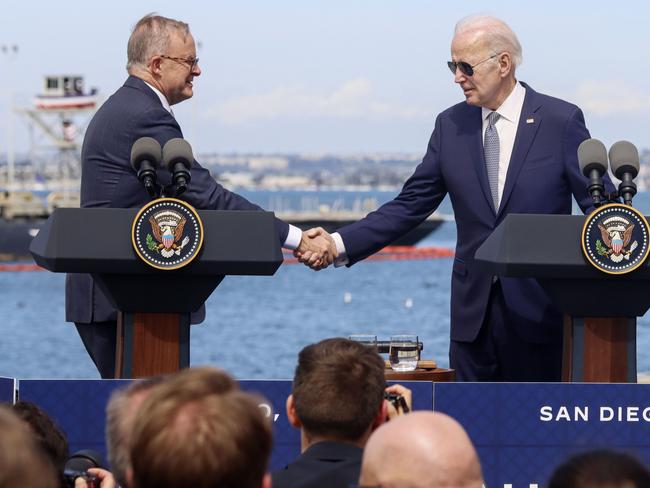
“The irony of #AUKUS is that two nuclear weapons states who claim to uphold the highest nuclear non-proliferation standard are transferring tons of weapons-grade enriched uranium to a non-nuclear-weapon state, clearly violating the object and purpose of the NPT,” it said on Twitter.”
It added “such a textbook case of double standard will damage the authority and effectiveness of the international non-proliferation system.”
The claim was dismissed by the Federal Government which said it was not producing or acquiring nuclear weapons and the nuclear fuel reactor was in a “sealed reactor” box for the life of its use and confirmed to all agreements made with the International Atomic Energy Agency.
Defence Minister Richard Marles said China was among the 60 regional leaders and nations contacted and offered detail on the AUKUS program. He could not say whether China had accepted a briefing or not.
Beijing has already stated it “firmly objects” to the alliance
China’s new foreign minister Qin Gang said the US Indo-Pacific policy specifically “provoked confrontation” and was an attempt to gang up and form blocs in an “Asian Pacific version of NATO”.
More than 20,000 jobs will be created over the next three decades, with the entire scheme to cost between $268bn and $368bn – the equivalent of 0.15 per cent of Australia’s gross domestic product averaged over the life of the program.
The AUKUS partners have agreed after an 18-month planning process to a four-phase plan which will:
INCREASE the regularity of US nuclear-powered submarines visiting Australia from this year, with more UK boats to visit from 2026.
ENABLE forward rotations of up to four US nuclear submarines and one UK boat through HMAS Stirling near Perth from 2027.
DELIVER three US Virginia-class nuclear submarines to Australia in the 2030s, with the potential for up to two more to be handed over to prevent a capability gap as the existing Collins-class fleet is retired. These boats – which could be new or second-hand – will also be based out of Western Australia.
CREATE a new SSN-AUKUS fleet based on a UK design with cutting edge technology – including common combat and weapons systems – from all three countries.
The UK will start building its first boat this decade and deliver it in the late 2030s, before the first SSN-AUKUS built in South Australia goes into service in the early 2040s.
Speaking in front of the USS Missouri, a Virginia-class nuclear submarine, Mr Albanese said it was the beginning of “a new chapter in the relationship between our nation, the United States and Great Britain”.

“This is a genuine trilateral undertaking — all three nations stand ready to contribute and all three nations stand to benefit,” he said.
He hailed the SSN-AUKUS as “an Australian sovereign capability — built by Australians, commanded by the Royal Australian Navy and sustained by Australians in Australian shipyards”.
“Our agreement unlocks a set of transformative opportunities for jobs and skills and research and innovation,” Mr Albanese said alongside Mr Biden and Mr Sunak.
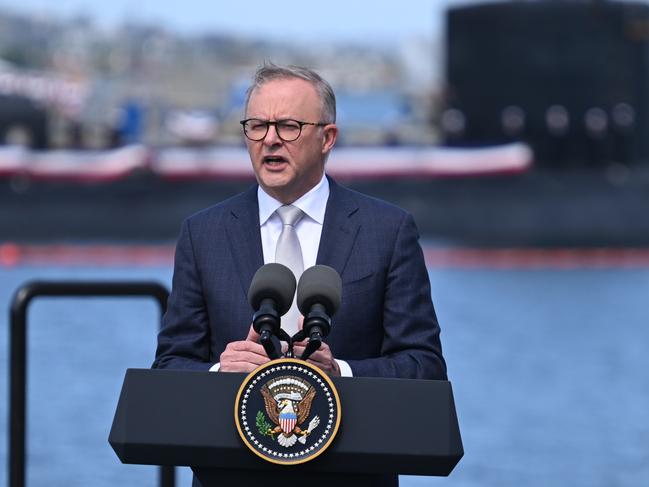
“Opportunities that will shape and strengthen and grow Australia’s economy for decades and create around 20,000 direct jobs for Australians from many trades and specialisations.”
“Our future security will be built and maintained not just by the courage and professionalism of our defence forces, but by the hard work and know-how of our scientists and engineers, our technicians and programmers, electricians and welders.”
The prime minister compared the forthcoming industrial effort to the creation of Australia’s automotive sector in the post-war period.
“Just as the vision of Curtin and Chifley in creating our automotive industry lifted our entire manufacturing sector, this investment will be a catalyst for innovation and research breakthroughs that will reverberate throughout the Australian economy and across every state and territory,” he said.
“I look out from here today and I see new frontiers in innovation to cross. New breakthroughs in technology to achieve. A new course for us to chart together.”
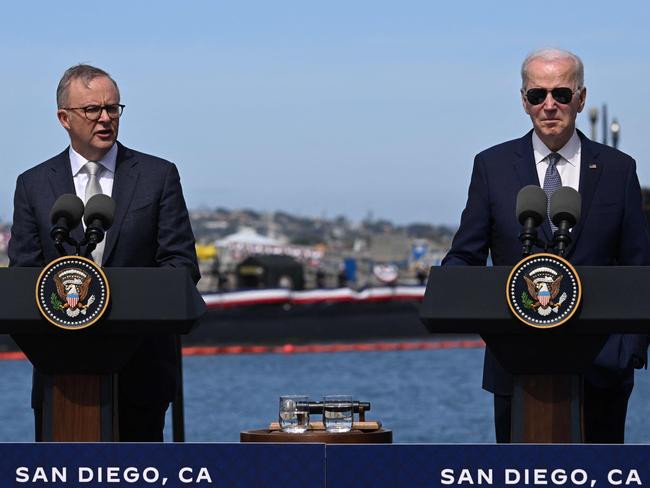
While he did not specifically call out China’s mounting aggression, Mr Albanese said the AUKUS partners were acting in line with their common values, and that they had an “unwavering conviction that whatever the challenges ahead, the cause of peace and freedom will prevail”.
“We are bound above all by our belief in a world where the sovereignty of every nation is respected, and the inherent dignity of every individual is upheld,” he said.
“Where peace, stability and security ensure greater prosperity and a greater measure of fairness for all. And where all countries are able to act in their sovereign interests free from coercion.”
Mr Biden said AUKUS had “an unusual name” but was a critical step for all three countries, and that the US could ask for “no better partners” in the Indo-Pacific than Australia and the UK.
Under the plan, the President said he was determined to help Australia develop its nuclear submarine capability as quickly as possible, including by selling at least three Virginia-class boats to Australia in the 2030s.

“The ultimate goal isn’t just selling subs to Australia — it’s developing something new together,” he said.
Mr Biden repeatedly emphasised that Australia’s submarines would not be armed with nuclear weapons and that Australia would not produce nuclear fuel for the boats, as he described America’s nuclear stewardship as a point of pride.
Mr Sunak unveiled a massive spending boost for the UK’s defence force to remain “one of the world’s leading defence powers”.
But he said this had to happen in partnership with the AUKUS allies, as he described the new nuclear submarine as one of the most advanced capabilities the world had ever known.
At the end of the event, Mr Biden looked to his fellow leaders and declared: “You’re the best, and we’re going to be the best in the world.”
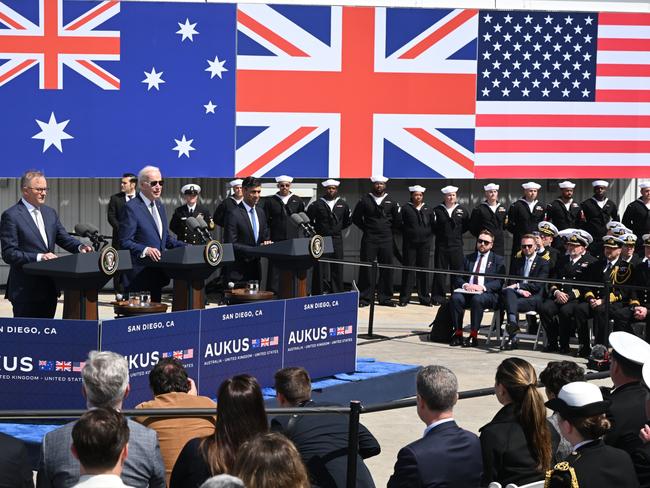
‘I’M COMING. NO WAY OUT’: BIDEN COMMITTED TO AUS TRIP
In a meeting between Mr Albanese and Mr Biden after the announcement – their fourth in person since Labor won last year’s election – the pair discussed their excitement at the President’s forthcoming visit to Australia for the Quad leaders’ summit.
“Remember, you invited me down to Australia. I’m coming,” Mr Biden said.
“I’m coming. No way out for you.”
Mr Albanese said he would also be returning to the US later this year for the APEC meeting, so they would “have to see a lot of each other on an ongoing basis”.
“We’ve been in very regular contact and developed a personal friendship and relationship of trust as well, which is something that should be there between our two great nations,” the Prime Minister said.
“As far as I’m concerned, that’s good,” Mr Biden replied.
The President, asked by reporters why he chose to partner with Australia on AUKUS, said: “They’re totally reliable.”
CHINA OFFERED BRIEFINGS ABOUT AUKUS SUBS DEAL
President Joe Biden’s national security adviser Jake Sullivan confirmed the US had briefed China about the AUKUS announcement.
“The subject of AUKUS has featured in conversations between US and China officials over the last 18 months,” he said.
“But we are specifically briefing them about this announcement so that they understand the terms of this.”
Asked whether the Chinese government viewed it as an escalation, Mr Sullivan said: “I can’t speak to how they see it. All I can speak to is how we have approached the issue, how we have been transparent and clear and straightforward.”
Defence Minister Richard Marles said he and his colleagues had contacted more than 60 countries to inform them of Australia’s submarine plan, including extensive conversations with leaders in the Indo-Pacific where there are lingering concerns about fuelling an arms race in the region.
Mr Marles confirmed Australia had offered a briefing to China, but said he “did not participate” in any communications and was “not aware” if Beijing had taken up the opportunity at this time.
French Defence Minister Sébastien Lecornu was given an extensive outline of the AUKUS plan almost a week ago, with Mr Marles describing Australia’s relationship with France as “in a good place”.
“Given all that occurred 18-months ago … I’m really grateful to Sebastian for the hearing that he gave me,” he said.
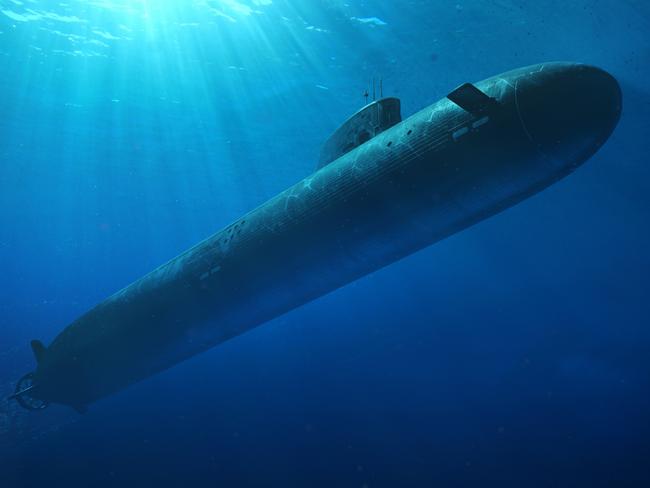
Meanwhile, the co-chairs of the US congressional AUKUS working group immediately threw their support behind the announcement and vowed to drive the necessary legislative changes, including to approve the sale of Virginia-class submarines to Australia.
Democrat Joe Courtney said it was a “seminal moment” for the US and its allies in upholding “peace, prosperity and the international rule of law”.
“This technology, which the US Navy has only shared once — in 1958, with the British Navy — will extend limitless reach and stealth to the Australian submarine fleet,” he said.
“All three countries have a lot of hard work ahead to size up their industrial bases and to train Australian sailors to operate this technology, all in a compressed timeline.”
“The presence of all three nations’ heads of state to reveal this plan and declare their determination to successfully execute its many components is a strong statement of commitment to our alliance, which I look forward to upholding in the US Congress on a bipartisan basis.”
Blake Moore, a Republican congressman, said it was a “seismic shift in great power competition”.
“I want to congratulate the Biden administration for delivering this win and am eager to get to work with my colleagues to expand our diverse coalition in Washington,” he said.
Republican Mike Gallagher added: “Now we must act with urgency to not only fully resource and implement this agreement, but also make the necessary policy choices to make AUKUS as successful as possible.”
US ambassador to Australia Caroline Kennedy also declared the deal had “strong bipartisan support in Congress”.
She maintained she was confident that it would not be threatened even by the potential future return of Donald Trump to the White House.
Asked whether the deal would inflame tensions with China, Ms Kennedy said AUKUS was designed to “secure the peace and stability of the region”.
It wasn’t all positive, with Greens Senator and Foreign Affairs, Peace and Nuclear Disarmament spokesman Jordon Steele-John describing the AUKUS pact as a “fundamental threat” to Australia’s independence and claiming it would undermine global efforts to tackle climate change.
“The AUKUS pact will see an unprecedented nuclearisation of our oceans and open Australia up to the risk of a nuclear disaster which would have effects that last generations,” he said.
“Make no mistake – there is not a single modern technology that has never failed.”
However Vice Admiral Jonathon Mead said the similarities between Australia’s current Collins class boats and the future nuclear options would enable a “low risk” transition.
“Essentially you could put Australian submariners on board a Virginia (submarine) now and everything forward (from the propulsion system) our submariners would be very familiar with,” he said.
Vice Admiral Mead said once US nuclear submarines started regularly coming through Western Australia, more Australian submariners would learn about the boat and be able to transfer that knowledge to when the country has its own vessels.
The SSN-AUKUS submarines would carry similar weapons and other systems to the Virginia Class.
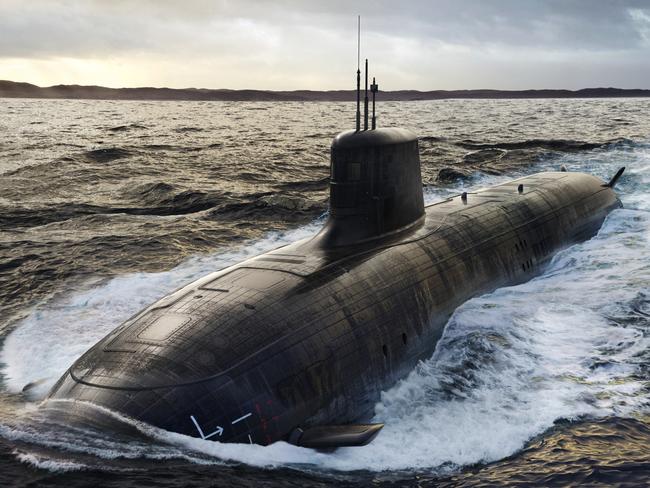
FEARS LABOR WILL ‘CANNIBALISE’ DEFENCE TO PAY FOR SUBS
Defence Minister Richard Marles said the government would release more details about how it plans to deliver the first four years of the AUKUS submarine project without spending any additional money ahead of the budget.
“You will get all of that information in the budget … in just a couple of months,” he said.
Mr Marles also said a decision on an east coast base location had not been made.
“It is the case that the former government announced the need for an east coast base, but we are taking our time here and all of that is a long way away.”
But Opposition leader Peter Dutton said it was not “credible” for the government to delay the release of details relating to costings and an east coast base.
“We cannot allow Labor to cannibalise the Defence Force to pay for all this,” he said.
Mr Dutton said the creation of an east coast base was critical for attracting more Australians into the industry, as currently all submariners are based in Western Australia.
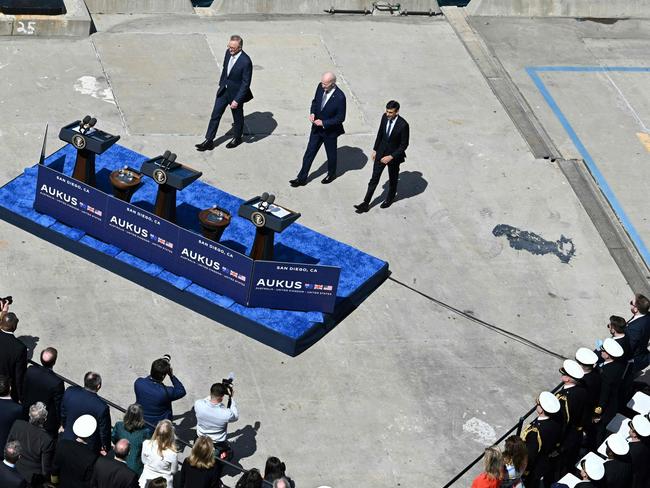
Defence Industry Minister Pat Conroy said over the life of the AUKUS submarine project Australia would be spending $30 billion on skills development.
“An apprentice who starts on his project today could work their entire career, building these submarines for Australia, which is a tremendous opportunity,” he said.
“We’ll also be upskilling workers in adjacent industries.”
Mr Conroy also said there would be opportunities for Australian companies to provide components to build the SSN-AUKUS submarines both for Australia and the UK.
“Opportunities identified where we could be competitive include around valves, pumps, batteries, and pipe fitting,” he said.
Similar weapons, combat, propulsion systems and sensors between the US Virginia Class nuclear-powered submarines and the future SSN-AUKUS boats will make it easier for Australia to operate both types in the coming decades.
‘SINGLE BIGGEST INVESTMENT’ IN AUSTRALIA’S DEFENCE
Earlier, Mr Albanese and Defence Minister Richard Marles said it was “the single biggest investment in our defence capability in our history and represents a transformational moment for our nation, our Defence Force and our economy”.
“Together with our AUKUS partners, the Albanese government will deliver the optimal pathway, providing a superior and sovereign capability, generations of jobs and a record level of investment which will keep Australians safe,” they said in a statement.
In a trilateral meeting prior to the announcement, asked by reporters whether the US could be relied upon to deliver the AUKUS plan, Mr Biden said: “We can always be relied upon.”
Australia will also spend up to $6.4bn to extend the life of its six conventional Collins-class boats into the 2040s, meaning the Navy may be operating three separate submarine models by then.
The life-of-type extensions will begin in 2026, supporting 1500 jobs at South Australia’s Osborne shipyard.
Overall, the government will invest $9bn in the May federal budget over the next four years, including $2bn in South Australia and $1bn in Western Australia.
Breaking: Australia will spend up to $368bn to deliver an historic nuclear submarine program featuring at least three boats bought from the US, upgrades to extend the life of our existing fleet and eight homemade subs hitting the water from the 2040s. https://t.co/2fohqQUDUSpic.twitter.com/BfA49rm4me
— Tom Minear (@tminear) March 13, 2023
Mr Albanese, Mr Biden and Mr Sunak said in a joint statement that the plan “elevates all three nations’ industrial capacity to produce and sustain interoperable nuclear-powered submarines for decades to come, expands our individual and collective undersea presence in the Indo-Pacific, and contributes to global security and stability”.
Hundreds of Australian civilian and military personnel will begin to work at US and UK shipyards from this year so they are trained to lead the industrial transformation down under.
Australia will also make a “proportional investment” in American and British shipyards of about $3bn over the next four years, while the US invests an extra $US2.4bn ($A3.6bn) by 2027 to boost its submarine construction capacity so it can maintain its own fleet before delivering Virginia-class boats to Australia next decade.
While the three leaders acknowledged the need for “robust, novel information sharing and technology co-operation”, the White House did not detail how it would cut through export controls that experts have warned could hamper the AUKUS plan.
In South Australia, the construction of a new nuclear submarine shipyard will start this year, supporting up to 4000 jobs at the peak.
A further 4000 to 5000 jobs will be supported at the peak of the submarine construction program in 20 to 30 years – almost double what was forecast for the cancelled French Attack-class submarine scheme.
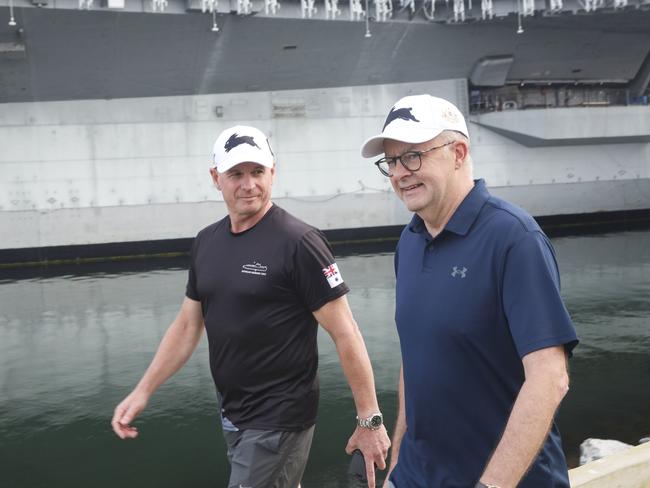
“The AUKUS submarines will be the most complex machines that have ever been built in human history. And they will be built here in South Australia,” South Australian Premier Peter Malinauskas said.
Construction will begin in South Australia this decade on the first SSN-AUKUS boat, which is due to be ready in the early 2040s. One is expected to be produced every three years after that, taking the life of the program out to the 2050s.
Over the next decade, up to $8bn will also be invested in a massive upgrade of WA’s HMAS Stirling base, creating 3000 jobs. This will cater for the forward rotation of US and UK nuclear submarines and provide opportunities for Australian workers to pitch in on maintenance work.
A separate nuclear submarine base will also be built on Australia’s east coast but the Albanese government is yet to confirm its location.
A new workforce strategy to deliver on the AUKUS plan will include a dedicated skills and training academy in South Australia, a nationwide training plan with universities and vocational education providers, and new nuclear science and engineering courses.
The AUKUS leaders maintained the submarine plan would comply with all nuclear non-proliferation requirements, with reactors provided to Australia in welded units that will not require refuelling.
Defence land is likely to be used to dispose of nuclear waste in a new purpose-built facility.
More Coverage
Originally published as Anthony Albanese reveals $368bn AUKUS nuclear subs deal to become major naval power




